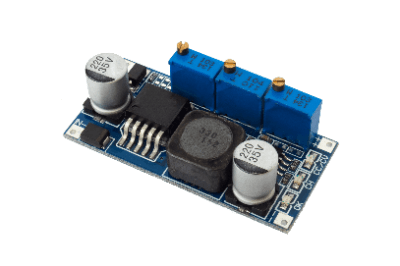What Is a DC/DC Converter?

A DC/DC converter is a power supply device that generates varying DC voltages from a constant DC power source.
A converter that outputs a higher voltage than the input DC voltage is called a boost converter, while a converter that outputs a lower voltage is called a buck converter.
Applications of DC/DC Converters
DC/DC converters are used to provide suitable power supply voltages for some circuits inside electronic equipment.
Generally, electronic equipment operates using commercial power (AC), but electronic circuits require a DC power supply, so the commercial power supply is converted to DC. This power circuit is called an AC/DC converter.
On the other hand, since the optimum operating voltage range for electronic components such as ICs that make up a circuit differs from each other, the appropriate voltage must be supplied to each individual circuit. In such cases, DC/DC converters are used.
Principle of DC/DC Converter
There are two types of DC/DC converters, each with a different principle.
1. Linear Regulator
In a linear regulator, an NPN transistor is inserted between the input and output terminals, and the output voltage is maintained constantly. by controlling the voltage between the collector and emitter of the transistor. The transistor has the collector on the input side and the emitter on the output side. The control circuit detects the difference between the output voltage and the desired voltage.
The basic operation is to control the base current of the transistor and vary the voltage between the collector and emitter to keep the output voltage constant. The control circuit controls the gate voltage.
2. Switching Regulator
The basic operation of a switching regulator is to install a switching element between the input and output terminals. In addition, switching regulators supply power from the input to the output with the switching element in the ON state until the output voltage reaches the desired voltage, and then turn the switching element OFF when the output voltage reaches the desired voltage.
This operation is repeated at high speed to control the output voltage and to keep it within the desired range. In switching regulator type, DC To DC Converters in combination with an inductor can reverse voltage generated from the inductor at the time of current interruption and can be used for boost operation to obtain a higher voltage than the input voltage.
In addition, a step-up/step-down regulator that can output a constant voltage regardless of the input side voltage, as well as an inverting regulator that creates a negative voltage from a positive voltage, can also be realized.
Types of DC/DC Converters
There are two main types of DC/DC converters: linear regulators and switching regulators.
1. Linear Regulator
An NPN type transistor is inserted between the input and output terminals to control the output voltage so that it is always constant.
The output voltage is lower than the input voltage.
Energy efficiency is poor and heat generation is high due to high transistor losses.
2. Switching Regulator
A switching element is installed between the input and output terminals, and the current flowing from the input terminal is turned on and off by the switching element to maintain the voltage at the output terminal at a constant level, which has the following advantages:
- Depending on the circuit configuration, it can be used with either a boost converter or a buck converter.
- High energy efficiency and low overall circuit heat generation.
On the other hand, the disadvantages are as follows:
- Switching noise is generated and spike noise or ripple appears on the output.
- The number of components is large and the circuit size is large.
How to Use DC/DC Converters
Linear regulators provide stable voltage output with low noise and are suitable for analog circuits, such as when handling weak signals from various sensors. However, since they generate a large amount of heat, proper heat dissipation design is required. Consideration must be given to dissipate the generated heat to the outside of the device by using heat sinks or fans in combination.
Switching regulators, on the other hand, allow a wide range of output voltage settings and can supply large currents, but they inevitably generate noise, which may require countermeasures. An example of such a countermeasure is to place the device in a shielded case.
However, to prevent noise from penetrating into analog circuits, it may be necessary to separate the power supply itself and ground the DC/DC converter and analog circuits at a common ground level by grounding them at a single point.
Also, although heat generation is relatively low, when outputting a large amount of power, it is necessary to design the device with sufficient attention to heat dissipation inside the device, as is the case with linear regulators.